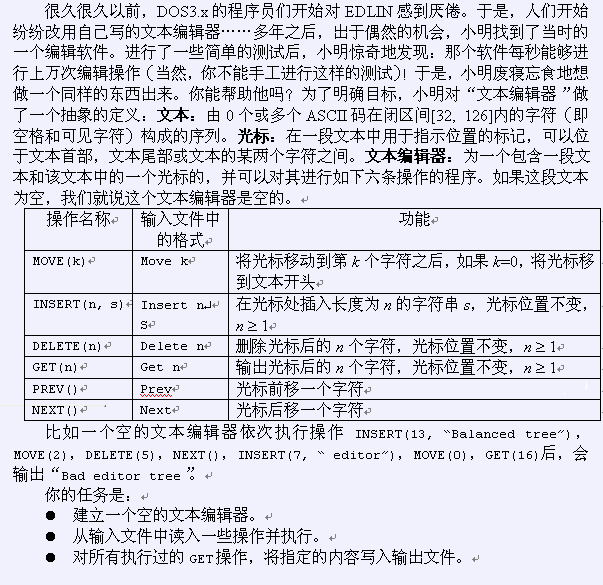Description

Input
輸入文件editor.in的第一行是指令條數t,以下是需要執行的t個操作。其中: 為了使輸入文件便於閱讀,Insert操作的字符串中可能會插入一些回車符,請忽略掉它們(如果難以理解這句話,可以參考樣例)。 除了回車符之外,輸入文件的所有字符的ASCII碼都在閉區間[32, 126]內。且行尾沒有空格。 這裡我們有如下假定: MOVE操作不超過50000個,INSERT和DELETE操作的總個數不超過4000,PREV和NEXT操作的總個數不超過200000。 所有INSERT插入的字符數之和不超過2M(1M=1024*1024),正確的輸出文件長度不超過3M字節。 DELETE操作和GET操作執行時光標後必然有足夠的字符。MOVE、PREV、NEXT操作必然不會試圖把光標移動到非法位置。 輸入文件沒有錯誤。 對C++選手的提示:經測試,最大的測試數據使用fstream進行輸入有可能會比使用stdio慢約1秒。Output
輸出文件editor.out的每行依次對應輸入文件中每條GET指令的輸出。Sample Input
15 Insert 26 abcdefghijklmnop qrstuv wxy Move 16 Delete 11 Move 5 Insert 1 ^ Next Insert 1 _ Next Next Insert 4 .\/. Get 4 Prev Insert 1 ^ Move 0 Get 22
Sample Output
.\/. abcde^_^f.\/.ghijklmno
Source
NOI2003
#include#include #include #include #include using namespace std; using namespace __gnu_cxx; const int maxn=1024*1024*2+10; crope txt; char op[10],str[maxn]; int pos=0; int main() { int T_T,x,y,z; scanf("%d",&T_T); while(T_T--) { scanf("%s",op); if(op[0]=='M') { scanf("%d",&pos); } else if(op[0]=='I') { scanf("%d",&x); y=0; while(x) { char c=getchar(); if(c>=32&&c<=126) { str[y++]=c; x--; } } str[y]=0; txt.insert(pos,str); } else if(op[0]=='D') { scanf("%d",&x); txt.erase(pos,x); } else if(op[0]=='G') { scanf("%d",&x); puts(txt.substr(pos,x).c_str()); } else if(op[0]=='P') pos--; else if(op[0]=='N') pos++; } return 0; }